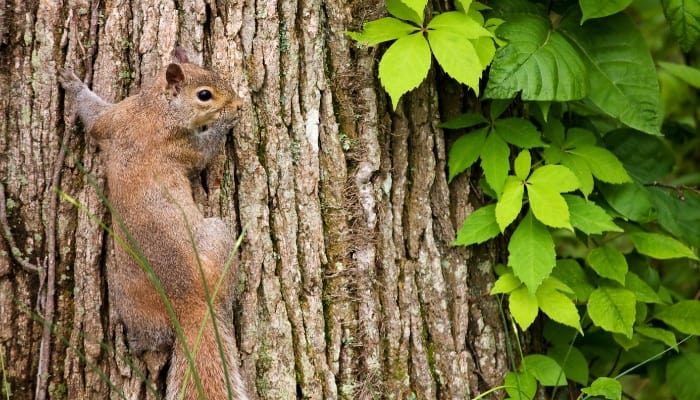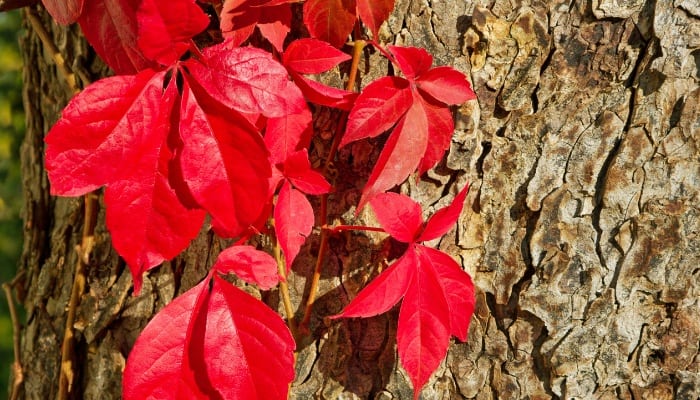The Virginia creeper vine (Parthenocissus quinquefolia) is aptly named for its tendency to creep and grow in unexpected places.
While its foliage will add color and lushness to a forest, it should be stopped before it grows to cover all of a tree and the surrounding plants.
Will Virginia creeper kill a tree? If left unmanaged, the perennial vine known as Virginia creeper will kill a tree. Over time, it will begin to totally encompass the tree, preventing it from photosynthesizing, or the vine will wrap tightly around a portion of the tree, cutting off nutrients and eventually killing the tree.
While Virginia creeper will kill a tree before you even realize it’s happening, there are plenty of ways to prohibit it from doing so.
It will grow quickly and spread out through a forest, out-competing other species.
Continue reading to better understand the Virginia creeper vine, how quickly it will grow, reasons to keep it out of your garden, and just a few reasons to like it!
Does Virginia Creeper Kill Trees?
While not poisonous to trees, Virginia creeper has the ability to grow quickly, smothering trees and other plants nearby.
Its invasive growth rate as well as its ability to thrive with little sun make it something to keep on your radar!
Virginia Creeper Growth Rate
The growth rate of the woody vine is extremely fast. It averages 20 feet per year in length and extends to 100 feet long after growing for a few seasons.
The more area it has to root, the further it will extend, and it will grow even quicker!
How Does Virginia Creeper Spread?
Virginia creeper is very invasive and can spread easily because it roots anywhere the vine touches the ground.
It also produces small berries that songbirds love. The seeds are then spread effortlessly around through their droppings as they fly.
What Does Virginia Creeper Do To Trees?
Mostly growing about a foot off the ground, Virginia creeper will do just as its name says — creep! Anytime it reaches another plant or tree, it will grab on and begin to engross it, climbing toward the sun.
It will begin to wrap the tree in its vines, eventually covering the branches and leaves completely. This will limit the ability of the tree to photosynthesize and will eventually kill it.
Should Virginia Creeper Be Removed From Trees?
Yes! While it adds a lush forest look to the thick of the woods, it will become unstoppable once it reaches a certain point.
Remove it while it is just beginning to establish itself on the tree before it encompasses the entire tree.
How Do I Get Rid of Virginia Creeper on My Tree?
The easiest way to get rid of Virginia creeper is to pull it off the tree. If it has become too much to remove stem by stem, sever the vines at the base of the tree. This will cut off the supply of nutrients and kill all of the vines in the tree. The vines will slowly deteriorate.

Additional Virginia Creeper Problems
In addition to killing trees that it overtakes, Virginia creeper has other negative attributes that make it an unfavorable plant. Take a look at these other reasons why you should always be monitoring the vine.
1. Toxicity
Its berries contain oxalic acid, which is considered toxic to humans, dogs, and most other mammals. Be sure to refrain from letting dogs or children play near the plant.
2. Very Hard To Get Rid Of
Since it roots at so many different points, it is difficult to fully remove the vine. Its berries also contain countless seeds that spread easily and sprout quickly.
It will hold on to structures and plants with small aerial roots, making it difficult to remove in one piece.
3. Can Cause Damage to Structures
Since its aerial roots, or “holdfasts,” will cling to almost any surface, they don’t let go easily. Many times, even years after the plants have been removed, the tiny aerial roots will still be stuck to the wall.
When removing the vine, it may peel paint or stucco or chip the surface from which it is being removed.
4. Will Quickly Overtake Other Vegetation
Growing as quickly as it does, many other plants don’t stand a chance. Grabbing onto and creeping over other plants, Virginia creeper smoothers them easily. This reduces its competition for sunlight, water, and soil nutrients.
5. Skin Irritant
While simply touching its leaves may cause irritation from the small hairs that cover them, severing the vine or crushing a leaf may cause its sap to become exposed.
The sap contains an irritant that will cause discomfort if it comes into contact with your skin.
6. Aggressive Root System
Virginia creeper’s root system is aggressive below the ground just as it is above the ground! Spreading its roots out quickly and rooting where any vines come into contact with the soil, it may begin to grow again if any roots are left in the soil.
Virginia Creeper Uses
While it seems like nothing good can come of having this vine around, it serves its environmental niche just like every other living thing.
Without it, a part of the food web is missing. For animals and humans, the Virginia creeper has special attributes we must give it credit for!
Medicinal Value
Mainly used to make a hot decoction, Virginia creeper has been used by Native Americans to treat jaundice, diarrhea, swelling, and lockjaw and as a urinary aid.
Ornamental Value
While Virginia creeper can be destructive when allowed to grow on soft-sided structures of paint, stucco, or similar materials, it is grown on masonry without concern of damaging the stone.
It is commonly used to cover fences, walls, and other surfaces that it will not damage.
Wildlife Value
The berries of this vine are loved by songbirds, and it attracts them in the summer months when they ripen. The vine also creates dense foliage for small critters to nest in.
Structural Value
Its root system and crawling habit help to provide structure to the soil. It helps prevent erosion as it acts like a fibrous network of supports that dig in the soil, helping to prevent the deterioration of hillsides and mudslides during heavy rain.
Related Questions:
Is Virginia Creeper a Weed?
Virginia creeper is considered a weed to most people, and it grows quickly like a weed. It can be used for ornamental purposes to cover unsightly things like walls and is commonly seen covering buildings or highway overpasses.
What Eats Virginia Creeper?
The leaves are not a known food source for animals, and since it has toxic attributes, it is normally disregarded. However, it produces berries that are loved and enjoyed by songbirds when they come into season.
Closing Thoughts
The Virginia creeper vine is one to keep your eyes on, mainly for its invasive growing habit but also for its beautiful foliage color change in the fall and the lovely songbirds it brings to the area.
Maintained in the appropriate way, it can make a great plant to have around for its lush appearance and fast growing habit!

